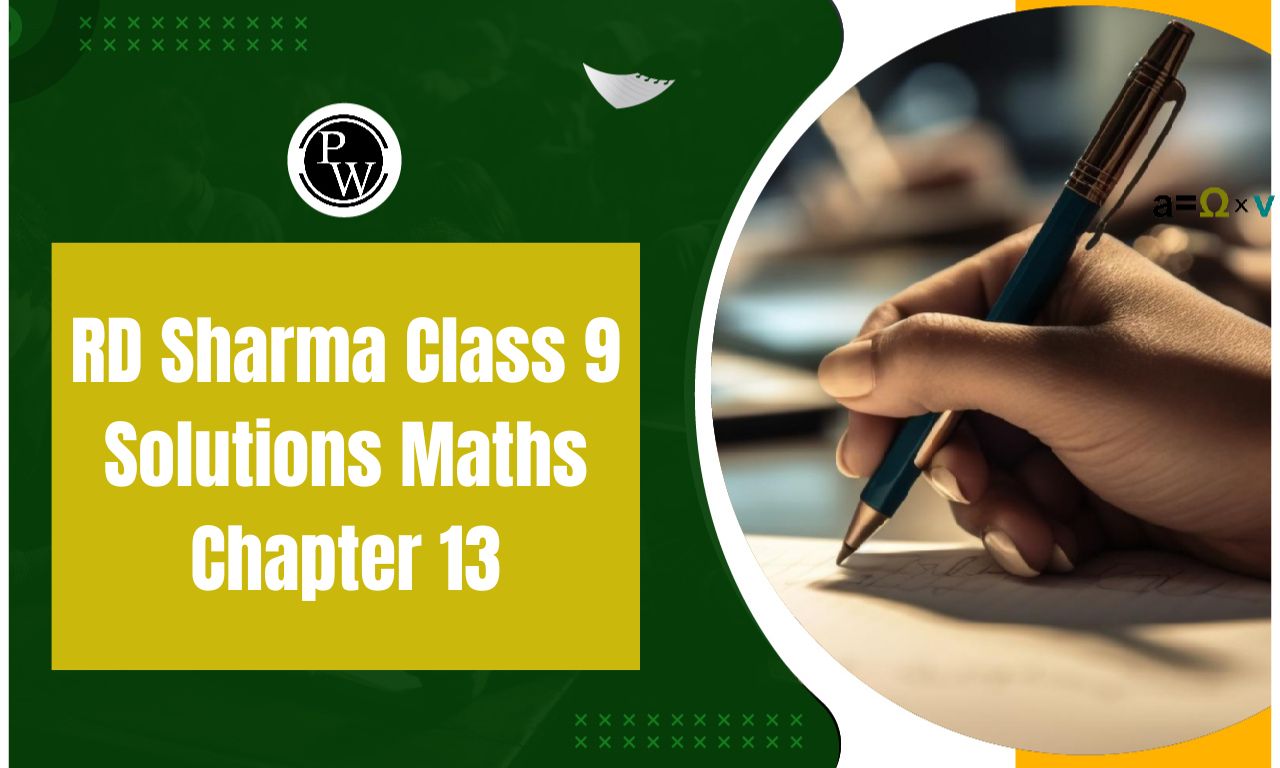

RD Sharma Solutions Class 9 Maths Chapter 13: This RD Sharma Class 9 Solutions Maths Chapter 13 on Linear Equations in Two Variables. The study of linear equations in two variables is the focus of this chapter.
If an equation can be expressed in the form axe + by + c=0, where a, b, and c are real integers and the coefficients of x and y, that is, a and b, respectively, do not equal zero, then the equation is considered to be linear in two variables. Students need to practice the RD Sharma Solutions as much as they can to become proficient in swiftly and simply solving issues. Students can use the RD Sharma Solutions for Class 9, which has been solved by subject matter experts in compliance with the CBSE syllabus, if they want to score highly on exams. Students will study several crucial procedures for solving linear equations in two variables in Chapter 13. They must also examine how the claims are expressed in terms of an equation.RD Sharma Solutions Class 9 Maths Chapter 13 PDF
Here we have provided RD Sharma Class 9 Solutions Maths Chapter 13 solutions for the students to help them ace their examinations. Students can refer to these solutions and practice these questions to score better in the exams.RD Sharma Class 9 Solutions Maths Chapter 13 PDF
RD Sharma Solutions Class 9 Maths Chapter 13 Linear Equations in Two Variables
RD Sharma Solutions Class 9 Maths Chapter 13 Exercise 13.1
Question 1: Express the following linear equations in the form ax + by + c = 0 and indicate the values of a, b, and c in each case:
(i) -2x + 3y = 12 (ii) x – y/2 – 5 = 0 (iii) 2x + 3y = 9.35
(iv) 3x = -7y (v) 2x + 3 = 0 (vi) y – 5 = 0
(vii) 4 = 3x (viii) y = x/2
Solution:
(i) Given an equation, -2x + 3y = 12
Or – 2x + 3y – 12 = 0 Comparing the given equation with ax + by + c = 0 We get, a = – 2; b = 3; c = -12(ii) Given equation, x – y/2 – 5= 0
Comparing the given equation with ax + by + c = 0 , We get, a = 1; b = -1/2, c = -5(iii) Given equation, 2x + 3y = 9.35
or 2x + 3y – 9.35 =0 Comparing the given equation with ax + by + c = 0 We get, a = 2 ; b = 3 ; c = -9.35(iv) Given an equation, 3x = -7y
or 3x + 7y = 0 Comparing the given equation with ax+ by + c = 0, We get, a = 3 ; b = 7 ; c = 0(v) Given equation, 2x + 3 = 0
or 2x + 0y + 3 = 0 Comparing the given equation with ax + by + c = 0, We get, a = 2 ; b = 0 ; c = 3(vi) Given equation, y – 5 = 0
or 0x + y – 5 = 0 Comparing the given equation with ax + by+ c = 0, We get, a = 0; b = 1; c = -5(vii) Given equation, 4 = 3x
or 3x + 0y – 4 = 0 Comparing the given equation with ax + by + c = 0, We get, a = 3; b = 0; c = -4(viii) Given an equation, y = x/2
Or x – 2y = 0 Or x – 2y + 0 = 0 Comparing the given equation with ax + by + c = 0 , We get, a = 1; b = -2; c = 0Question 2: Write each of the following as an equation in two variables:
(i) 2x = -3 (ii) y=3 (iii) 5x = 7/ 2 (iv) y = 3/2x
Solution:
(i) Given an equation, 2x = -3
Two variables can be used to express the equation mentioned above., 2x + 0y + 3 = 0(ii) Given equation, y = 3
Two variables can be used to express the equation mentioned above., 0 x + y – 3 = 0(iii) Given equation, 5x = 7/2
Two variables can be used to express the equation mentioned above., 5x + 0y – 7/2 = 0 or 10x + 0y – 7 = 0(iv) Given an equation, y = 3/2 x
Two variables can be used to express the equation mentioned above., 2y = 3x 3x – 2y = 0 3x – 2y + 0 = 0Question 3: The cost of a ball pen is Rs 5, less than half of the cost of a fountain pen. Write this statement as a linear equation in two variables.
Solution:
Let the cost of a fountain pen be y and the cost of a ball pen be x. According to the given statement, x = y/2 − 5 or 2x = y – 10 or 2x – y + 10 = 0 Which is required linear equation.RD Sharma Solutions Class 9 Maths Chapter 13 Exercise 13.2
Question 1: Write two solutions for each of the following equations:
(i) 3x + 4y = 7
(ii) x = 6y
(iii) x + πy = 4
(iv) 2/3x – y = 4.
Solution:
(i) 3x + 4y =7 ….(1)
Step 1: Isolate the above equation in y. Subtract 3x from both sides, 3x + 4y – 3x = 7 – 3x 4y = 7 – 3x Divide each side by 4 y = 1/4 x (7 – 3x) ….(2) Step 2: Find Solutions Substituting x = 1 in (2) y = 1/4 x (7 – 3) = 1/4 x 4 = 1 Thus x = 1 and y = 1 is the solution of 3x + 4y = 7 Again, Substituting x = 2 in (2) y = 1/4 x (7 – 3 x 2) = 1/4 x 1 = 1/4 Thus x = 2 and y = 1/4 is the solution of 3x + 4y = 7 Therefore, (1, 1) and (2, 1/4) are two solutions of 3x + 4y = 7.(ii) Given: x = 6y
Substituting x =0 in the given equation, 0 = 6y or y = 0 Thus (0,0) is one solution Again, substituting x=6 6 = 6y or y = 1 Thus, (6, 1) is another solution. Therefore, (0, 0) and (6, 1) are two solutions of x = 6y.(iii) Given: x + πy = 4
Substituting x = 0 ⇒ 0 + πy = 4 ⇒ y = 4/ π Substituting y = 0 ⇒ x + 0 = 4 ⇒ x = 4 Therefore, (0, 4/ π) and (4, 0) are two solutions of x + πy = 4.(iv) Given: 2/3 x – y = 4
Substituting x = 0 ⇒ 0 – y = 4 ⇒ y = -4 Substituting x = 3 ⇒ 2/3 × 3 – y = 4 ⇒ 2 – y = 4 ⇒ y = -2 Therefore, (0, -4) and (3, -2) are two solutions of 2/3 x – y = 4.Question 2: Write two solutions of the form x = 0, y = a and x = b, y = 0 for each of the following equations :
(i) 5x – 2y =10
(ii) -4x + 3y =12
(iii) 2x + 3y = 24
Solution:
(i) Given: 5x – 2y = 10
Substituting x = 0 ⇒ 5 × 0 – 2y = 10 ⇒ – 2y = 10 ⇒ – y = 10/2 ⇒ y = – 5 Thus x =0 and y = -5 is the solution of 5x-2y = 10 Substituting y = 0 ⇒ 5x – 2 x 0 = 10 ⇒ 5x = 10 ⇒ x = 2 Thus x =2 and y = 0 is a solution of 5x – 2y = 10(ii) Given, – 4x + 3y = 12
Substituting x = 0 ⇒ -4 × 0 + 3y = 12 ⇒ 3y = 12 ⇒ y = 4 Thus x = 0 and y = 4 is a solution of the -4x + 3y = 12 Substituting y = 0 ⇒ -4 x + 3 x 0 = 12 ⇒ – 4x = 12 ⇒ x = -3 Thus x = -3 and y = 0 is a solution of -4x + 3y = 12(iii) Given, 2x + 3y = 24
Substituting x = 0 ⇒ 2 x 0 + 3y = 24 ⇒ 3y =24 ⇒ y = 8 Thus x = 0 and y = 8 is a solution of 2x+ 3y = 24 Substituting y = 0 ⇒ 2x + 3 x 0 = 24 ⇒ 2x = 24 ⇒ x =12 Thus x = 12 and y = 0 is a solution of 2x + 3y = 24Question 3: Check which of the following are solutions of the equation 2x – y = 6 and which are not:
(i) ( 3 , 0 ) (ii) ( 0 , 6 ) (iii) ( 2 , -2 ) (iv) (√3, 0) (v) (1/2 , -5 )
Solution:
(i) Check for (3, 0)
Put x = 3 and y = 0 in equation 2x – y = 6 2(3) – (0) = 6 6 = 6 True statement. ⇒ (3,0) is a solution of 2x – y = 6.(ii) Check for (0, 6)
Put x = 0 and y = 6 in 2x – y = 6 2 x 0 – 6 = 6 -6 = 6 False statement. ⇒ (0, 6) is not a solution of 2x – y = 6.(iii) Check for (2, -2)
Put x = 0 and y = 6 in 2x – y = 6 2 x 2 – (-2) = 6 4 + 2 = 6 6 = 6 True statement. ⇒ (2,-2) is a solution of 2x – y = 6.(iv) Check for (√3, 0)
Put x = √3 and y = 0 in 2x – y = 6 2 x √3 – 0 = 6 2 √3 = 6 False statement. ⇒ (√3, 0) is not a solution of 2x – y = 6.(v) Check for (1/2, -5)
Put x = 1/2 and y = -5 in 2x – y = 6 2 x (1/2) – (-5) = 6 1 + 5 = 6 6 = 6 True statement. ⇒ (1/2, -5) is a solution of 2x – y = 6.Question 4: If x = -1, y = 2 is a solution of the equation 3x + 4y = k, find the value of k.
Solution:
Given, 3 x + 4 y = k (-1, 2) is the solution of 3x + 4y = k, so it satisfies the equation. Substituting x = -1 and y = 2 in 3x + 4y = k, we get 3 (– 1 ) + 4( 2 ) = k – 3 + 8 = k k = 5 The value of k is 5.Question 5: Find the value of λ, if x = –λ and y = 5/2 is a solution of the equation x + 4y – 7 = 0
Solution:
Given, (-λ, 5/2) is a solution of equation 3x + 4y = k Substituting x = – λ and y = 5/2 in x + 4y – 7 = 0, we get – λ + 4 (5/2) – 7 =0 -λ + 10 – 7 = 0 λ = 3Question 6: If x = 2 α + 1 and y = α -1 is a solution of the equation 2x – 3y + 5 = 0, find the value of α.
Solution:
Given, (2 α + 1, α – 1 ) is the solution of equation 2x – 3y + 5 = 0. Substituting x = 2 α + 1 and y = α – 1 in 2x – 3y + 5 = 0, we get 2(2 α + 1) – 3(α – 1 ) + 5 = 0 4 α + 2 – 3 α + 3 + 5 = 0 α + 10 = 0 α = – 10 The value of α is -10.Question 7: If x = 1 and y = 6 is a solution of the equation 8x – ay + a^2 = 0, find the values of a.
Solution:
Given, (1, 6) is a solution of equation 8x – ay + a^2 = 0 Substituting x = 1 and y = 6 in 8x – ay + a^2 = 0, we get 8 x 1 – a x 6 + a^2 = 0 ⇒ a^2 – 6a + 8 = 0 (quadratic equation) Using quadratic factorization a^2 – 4a – 2a + 8 = 0 a(a – 4) – 2 (a – 4) = 0 (a – 2) (a – 4)= 0 a = 2, 4 Values of a are 2 and 4.RD Sharma Solutions Class 9 Maths Chapter 13 Exercise 13.3
Question 1: Give the equations of two lines passing through (3, 12). How many more such lines are there, and why?
Solution:
Since a = 3 and b = 12 is the solution of the required equations. So, we have to find the set of any two equations which satisfy this point. Consider 4a – b = 0 and 3a – b + 3 = 0 set of lines which are passing through (3, 12). We know that infinite lines can pass through a point. So, infinite lines are passing through (3, 12).Question 2: A three-wheeler scooter charges Rs 15 for the first kilometer and Rs 8 each for every subsequent kilometer. For a distance of x km, an amount of Rs y is paid. Write the linear equation representing the above information.
Solution:
Let the total fare for covering the distance of ‘x’ km is given by Rs y As per the given statement; y = 15 + 8(x – 1) y = 15 + 8x – 8 y = 8x + 7 The above equation represents the linear equation for the given information.Question 3: A lending library has a fixed charge for the first three days and an additional charge for each day thereafter. Aarushi paid Rs 27 for a book kept for seven days. If fixed charges are Rs x and per-day charges are Rs y. Write the linear equation representing the above information.
Solution:
Aarushi paid Rs 27, of which Rs. x for the first three days and Rs. y per day for 4 more days given by x + (7 – 3) y = 27 x + 4y = 27 The above equation represents the linear equation for the given information.Question 4: A number is 27 more than the number obtained by reversing its digits. lf its unit’s and ten’s digits are x and y, respectively, write the linear equation representing the statement.
Solution:
Given: The original number is 27 more than the number obtained by reversing its digits The given number is in the form of 10y + x. The number produced by reversing the digits of the number is 10x + y. As per the statement: 10y + x = 10x + y + 27 10y – y + x – 10x = 27 9y – 9x = 27 9 (y – x) = 27 y – x = 3 x – y + 3 = 0 The above equation represents the required linear equation.Question 5: The Sum of a two-digit number and the number obtained by reversing the order of its digits is 121. If units and ten digits of the number are x and y, respectively, then write the linear equation representing the above statement.
Solution:
As per the statement given, the number is 10y + x. On reversing the digits of the number, we get 10x + y The sum of the two numbers is 121. (Given) 10y + x + 10x + y = 121 11x + 11y = 121 x + y = 11 Which represents the required linear equation.Question 5: If the point (2, -2) lies on the graph of linear equation, 5x + ky = 4, find the value of k.
Solution:
Point (2,-2) lies on the given linear equation, which implies (2, -2) satisfies this equation 5x + ky = 4. Now, putting x = 2 and y = -2 in 5x + ky = 4 5 × 2 + ( -2 ) k = 4 10 – 2k = 4 2k = 10 – 4 2k = 6 k = 6/2 = 3 The value of k is 3.RD Sharma Solutions Class 9 Maths Chapter 13 FAQs
How to score 100 100 in maths class 9?
Is RD Sharma important for Class 9?
Which is the hardest chapter in maths class 9?












